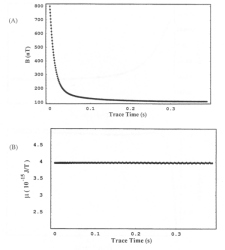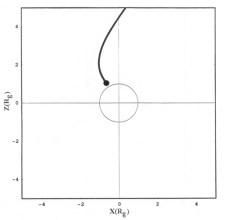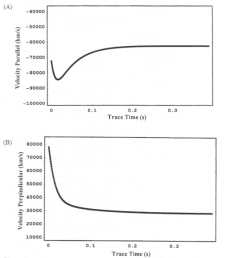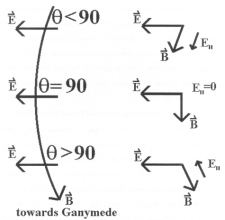Investigation of the Magnetosphere of Ganymede with Galileo's Energetic Particle Detector
Ph.D. dissertation by Shawn M. Stone, University of Kansas,
1999.
Copyright 1999 by Shawn M. Stone. Used with permission.
7.1 Feature G2-18:56:31, the Addition of Corotational Electric Field (continued)
A trace is done for subenergy 37 keV and sublook direction 1 at 25% of full corotation; the results are presented in Figures 7.15 through 7.20 and summarized in Table 7.3. A detailed analysis of these plots shows that if the corotational electric field is allowed to permeate into the magnetosphere of Ganymede, it can have a component parallel to the magnetic field. This can be seen most plainly from a plot of the perpendicular and parallel velocity components relative to the magnetic field vector shown in Figure 7.21. It can be seen that the parallel velocity first decreases then increases up to a steady state. What is physically happening is the orientation of the magnetic field varies because of the complicated geometry within the magnetosphere of Ganymede. The orientation of the corotational electric field is fixed in the region of Ganymede. The result is illustrated in Figure 7.22; the component of the corotational electric field parallel to B can vary even from parallel to anti-parallel. It is plain to see why then at 50% corotation there is enough parallel electric field to produce an anti-moon loss cone signature.
 |
Figure 7.15 (A) Length of the radius vector from the center of Ganymede to the particle as a function of trace time in seconds for subenergy 37 keV sublook direction 1 for model M1 channel E1. (B) The Z component of the particle position in GSII coordinates for subenergy 37 keV sublook direction 1 for model M1 channel E1. |
 |
Figure 7.16 (A) The X component of the particle position in GSII coordinates for subenergy 37 keV sublook direction 1 for model M1 channel E1. (B) The Z component of the particle position in GSII coordinates for subenergy 37 keV sublook direction 1 for model M1 channel E1. |
 |
Figure 7.17 (A) Magnetic field at the location of the particle as a function of trace time for subenergy 37 keV sublook direction 1 for model M1 channel E1. (B) Magnetic moment at the location of the particle as a function of trace time for subenergy 37 keV sublook direction 1 for model M1 channel E1. |
 |
Figure 7.18 (A) Velocity of the particle as a function of trace time for subenergy 37 keV sublook direction 1 for model M1 channel E1. (B) Pitch angle of the particle as a function of trace time for subenergy 37 keV sublook direction 1 for model M1 channel E1. |
 |
Figure 7.19 ZX projection of the trajectory for subenergy 37 keV sublook direction 1 for model M1 channel E1. |
 |
Figure 7.20 ZY projection of the trajectory for subenergy 37 keV sublook direction 1 for model M1 channel E1. |
 |
Figure 7.21 Model M1 E1 G2-18:56:31 subenergy 37 keV at .25 of full corotation. (A) The parallel component of the speed of the E1 particle relative to the magnetic field vector as a function of trace time. (B) The perpendicular component of the speed of the E1 particle relative to the magnetic field vector as a function of trace time. |
 |
Figure 7.22 A schematic representation of a magnetic field connected to Jupiter and Ganymede with corotational electric field permeating into the magnetosphere. In the three cases presented, the corotational electric field that permeates the magnetopause boundary can have three different components along the magnetic field. Case I: q > 90º. In this case the parallel component of the corotational electric field points away from Ganymede. Electrons will then have their mirror points pushed close to the surface of Ganymede. Case II: q = 90º. In this case the parallel component of the corotational electric field is zero. Case III: q < 90º. In this case the parallel component of the corotational electric field points toward Ganymede. Electrons will then have their mirror points pushed away from the surface of Ganymede. |
Table 7.3 Summary of the time-reversed particle trace presented in Figures 7.15 through 7.20 for subenergy 37 keV sublook direction 1 for model M1 channel E1 at 25% of full corotation.
| Figure | Information | Observation |
| 7.15 | (A) Radius of particle from Ganymede. (B) Z component of particle trajectory. | The E1 electron makes it out of the magnetosphere of Ganymede. |
| 7.16 | (A) X component of particle trajectory. (B) Y component of particle trajectory. | The E1 electron makes it out of the magnetosphere of Ganymede. |
| 7.17 | (A) Magnetic field sampled by the particle. (B) Magnetic moment sampled by the particle. | The magnetic field shows the transition from within the magnetosphere of Ganymede to the Jovian background field. The magnetic moment is conserved throughout the trajectory. |
| 7.18 | (A) Speed of the particle as it moves through its trajectory. (B) Pitch angle of the particle. | While in the Ganymede magnetosphere, the 25% of full corotation electric field decreases the energy of the E1 electrons until they make it out of the region. The pitch angle becomes near anti-field aligned. |
| 7.19 | ZX projection of the trajectory of the particle. | The electron is shown following the magnetic field line very closely. It makes it out of the magnetosphere of Ganymede. |
| 7.20 | ZY projection of the trajectory of the particle. | The electron is shown following the magnetic field line very closely. It makes it out of the magnetosphere of Ganymede. |
Return to dissertation table of contents page.
Return to main
Galileo Table of Contents Page.
Return to Fundamental
Technologies Home Page.
Updated 8/23/19, Cameron Crane
QUICK FACTS
Mission Duration: Galileo was planned to have a mission duration of around 8 years, but was kept in operation for 13 years, 11 months, and 3 days, until it was destroyed in a controlled impact with Jupiter on September 21, 2003.
Destination: Galileo's destination was Jupiter and its moons, which it orbitted for 7 years, 9 months, and 13 days.



